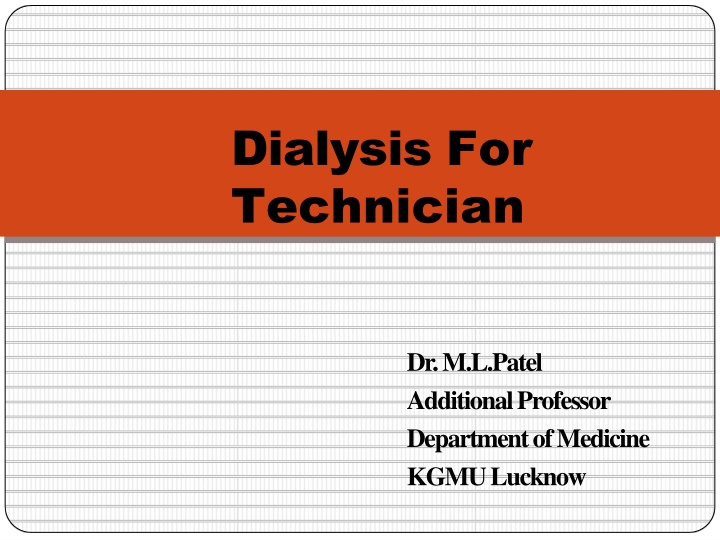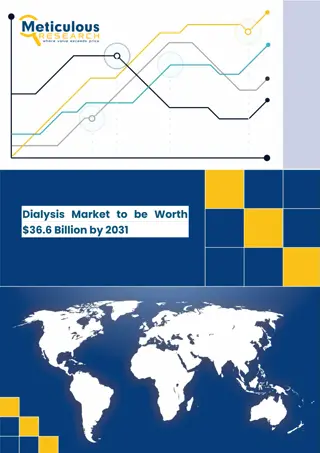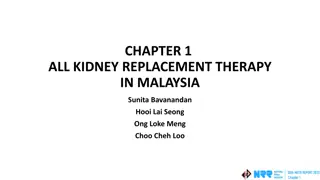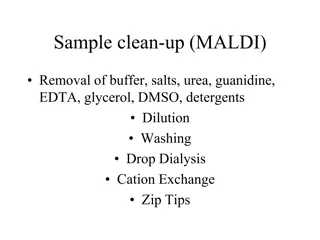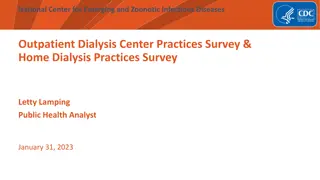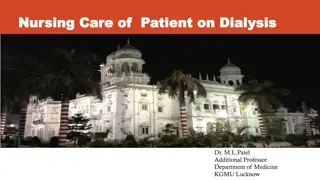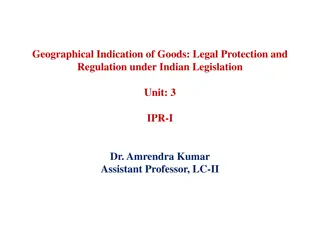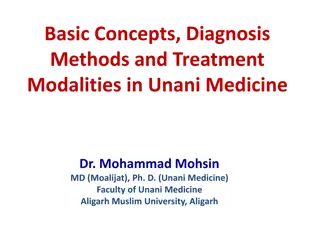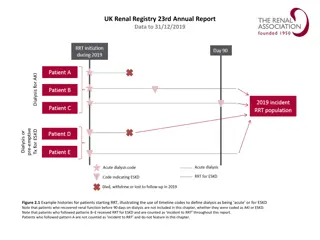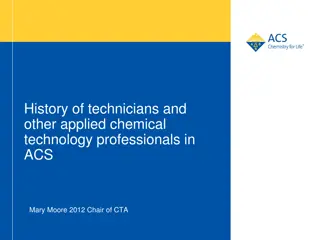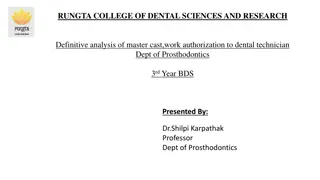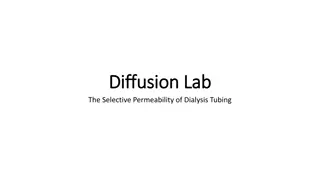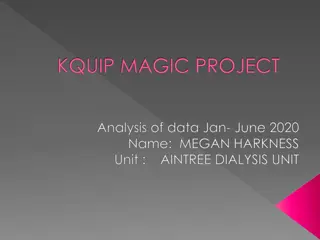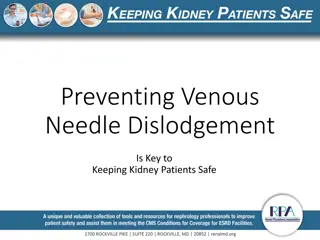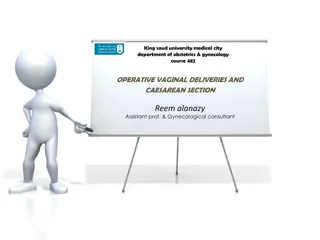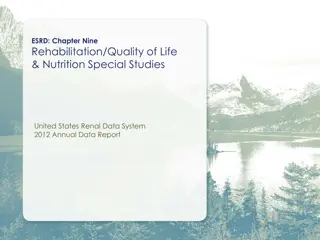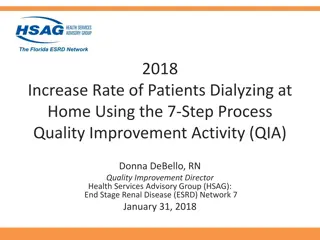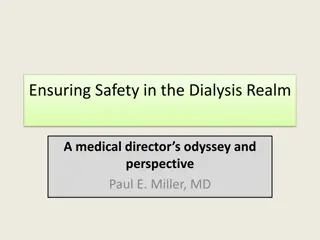Dialysis for Technicians - Indications, Modalities, and Principles Explained
Explore the essential aspects of dialysis for technicians, including indications such as pericarditis and fluid overload, different modalities like hemodialysis and peritoneal dialysis, and the principles behind solute clearance and fluid removal. Gain insights into the goals, modalities, and complications associated with dialysis procedures.
Download Presentation

Please find below an Image/Link to download the presentation.
The content on the website is provided AS IS for your information and personal use only. It may not be sold, licensed, or shared on other websites without obtaining consent from the author.If you encounter any issues during the download, it is possible that the publisher has removed the file from their server.
You are allowed to download the files provided on this website for personal or commercial use, subject to the condition that they are used lawfully. All files are the property of their respective owners.
The content on the website is provided AS IS for your information and personal use only. It may not be sold, licensed, or shared on other websites without obtaining consent from the author.
E N D
Presentation Transcript
Dialysis For Technician Dr. M.L.Patel Additional Professor Department of Medicine KGMU Lucknow
Outline Indications Modalities Apparatus Access Complications of dialysis access Acute complications ofdialysis
Indications Pericarditis or pleuritis Progressive uremic encephalopathy or neuropathy ( asterixis, myoclonus,seizures) Bleedingdiathesis Fluid overload unresponsive to diuretics Metabolic disturbances refractory to medical therapy (hyperkalemia, metabolic acidosis, hyper-calcemia , hyper- phosphatemia) Persistent nausea/vomiting, weight loss, ormalnutrition Toxic overdose of a dialyzable drug .Dialysable substance IgG/>>>>IgM
Indications forRRT Acute management of life-threatening complications ofAKI: A: Metabolic acidosis (pH less than 7.1) E: Electrolytes -- Hyperkalemia (K >6.5 meq/L) or rapidlyrising K) I: Ingestion -- Certain alcohol and drug intoxications O: Refractory fluidoverload U: Uremia, ie. pericarditis, neuropathy, decline in mentalstatus
Goals ofDialysis Soluteclearance Diffusive transport (based on countercurrent flow of blood anddialysate) Convective transport (solvent drag with ultrafiltration) Fluidremoval
Modalities Peritonealdialysis Intermittent hemodialysis Hemofiltration Continuous renal replacementtherapy Decision of modality determined by catabolic rate, hemodynamic stability, and whether primary goal is fluid or solute removal
Principles ofdialysis Dialysis = diffusion = passive movement of solutes across a semi- permeable membrane down concentrationgradient Good for smallmolecules (Ultra)filtration = convection = solute + fluid removal across semi- permeable membrane down a pressure gradient (solventdrag) Better for removal of fluid and medium- sizemolecules Faber. Nursing in Critical Care 2009; 14:4
Principles ofdialysis Hemodialysis = solute passively diffuses down concentration gradient Dialysate flows countercurrent to blood flow. Urea, creatinine, K move from blood todialysate Ca and bicarb move from dialysate toblood. Hemofiltration: uses hydrostatic pressure gradient to inducefiltration / convection plasma water + solutes acrossmembrane. Hemodiafiltration: combination of dialysis and filtration. Miller's Anesthesia, 7th ed. 2009 Foot. Current Anaesthesia and Critical Care 2005; 16:321-329
HemodialysisApparatus Dialyzer (cellulose, substituted cellulose, synthetic noncellulosemembranes) Dialysis solution (dialysate water must remain free of Al, Cu, chloramine, bacteria, andendotoxin) Tubing for transport of blood and dialysis solution Machine to power and mechanically monitor the procedure (includes air monitor, proportioning system, temperature sensor, urea sensor to calculateclearance)
HemodialysisAccess Acute dialysis catheter (vascular catheter, i.e. Quentin catheter) Cuffed, tunneled dialysis catheter(Permcath) Arteriovenousgraft Arteriovenousfistula
ArteriovenousFistula Preferred form of dialysisaccess Typically end-to-side vein-to-artery anastamosis Types Radiocephalic (first choice) Brachiocephalic (secondchoice) Brachiobasilic (third choice, requires superficialization ofbasilic vein, i.e.transposition) Lower extremity fistulae are rare
ArteriovenousGraft Synthetic conduit, usually polytetrafluoroethylene , between an artery and avein Either straight or looped Commonsites Straight forearm : Radial artery to cephalicvein Looped forearm : brachial artery to cephalicvein Straight upper arm : brachial artery to axillaryvein Looped upper arm : axillary artery to axillaryvein
Tunneled CuffedCatheters Dual lumencatheters Most commonly placed in the internal jugular vein, exiting at the upper, anteriorchest Can also be placed in the femoral vein Subclavian catheters should be avoided given the risk of subclavianstenosis
Dialysis Access : Time touse Graft Usually cannulated within weeks Vectra or flexine grafts can safely be cannulated after ~12 hours Fistula Median period of 100 days before cannulation in the U.S. andU.K. Initial cannulation should be performed with small gauge needles and low blood flow
Complications of AVF andAVG Thrombosis Infection (10% for A VG, 5% for transposed A VF , 2% for non- transposedA VF) Seromas Steal (6% of B-C A VF , 1% of R-CA VF) Aneurysms and pseudoaneurysms (3% of A VF , 5% ofA VG) Venous hypertension (usually 2/2 central venousstenosis) Heart failure (Avoid A VFs in pts with severely depressed L VEF) Localbleeding
Tunnel CuffedCatheters Indications Intermediate-duration vascular access during maturation of AVF orAVG Expected lifespan on dialysis of < 1 year (due to co-morbidities or on living donor transplant list) Medical contra-indication to permanent dialysis access (severe heartfailure) Patients who refuse AVF or AVG after explanation of the risks of a catheter All other dialysis access options have beenexhausted
Tunnel Cuffed Catheters: Complications Infection Risk of bacteremia 2.3 per 1000 catheter days or 20 to 25% over the average duration of use Dysfunction Defined as inability to sustain blood flow of >300 mL/min By this definition, 87% of catheters malfunction in their lifetime Central venousstenosis Mortality (may be influenced by selectionbias)
Tunnel Cuffed Catheters :Bacteremia Metastaticinfections Osteomyelitis, endocarditis, septic arthritis,suppurative thrombophlebitis, or epiduralabscess Risk factors : prolonged duration of usage, previous bacteremia, recent surgery, diabetes mellitus, ironoverload, immunosuppression,malnutrition
Tunnel Cuffed Catheters :Bacteremia Clinicalmanifestations Fevers or chills in catheter-dependent dialysis patients associated with positive blood cultures in 60 to 80% Less commonly : hypotension, altered mental status, catheter dysfunction, hypothermia, andacidosis
Tunnel Cuffed Catheters :Bacteremia EmpiricTreatment Vancomycin (load with 15-20 mg/kg and then 500-1000 mg after each HD session) plus either gentamicin (load with 2 mg/kg and then 1 mg/kg after each HD session) or ceftazidime (2 grams after each HD session) Avoid prolonged use of an aminoglycoside given the risk of ototoxicity with vestibulardysfunction
Tunnel Cuffed Catheters :Bacteremia Duration Catheter removal and replacement, early resolution of symptoms, blood cultures quickly negative : 2 to 3weeks Uncomplicated S. aureus infection : 4weeks Metastatic infection or persistently positive blood cultures : minimum 6 weeks Osteomyelitis : 6 to 8weeks
Acute Complications ofDialysis Hypotension(25-55%) Cramps(5-20%) Nausea and vomiting (5-15%) Headache(5%) Chest pain(2-5%) Back pain(2-5%) Itching(5%) Fever and chills (<1%)
Acute Complications ofDialysis Chestpain Can be associated with hypotension and dialysis disequilibrium syndrome Always consider angina, hemolysis, and (rarely) airembolism Consider pulmonary embolism if recent manipulation of thrombus and/or occlusion of the dialysisaccess
Acute Complications ofDialysis Hemolysis Suggestivefindingsinclude port wine appearance ofthe blood inthe venousline, afallinghematocrit, or complaintsofchest pain,SOB,and/or backpain Usually due to dialysis solution problems, including overheating, hypotonicity, and contamination with formaldehyde, bleach, chloramine, or nitrates in the water,or copper in the dialysistubing Treatment includes discontinuation of dialysis without blood return to the patient, and evaluation for hyperkalemia with medical treatment asnecessary
Acute Complications ofDialysis Arrhythmias Common during, and between, dialysistreatments Controversial whether due to disturbances in plasma potassium Treatment is similar to the non-dialysis population, except for medication dosingadjustments
Thank Thank you Blood and Dialysate have to run opposite to achieve optimum clearance ..Fluid and Solute you Learning is always unidirectional ..Institute toIndividual.
